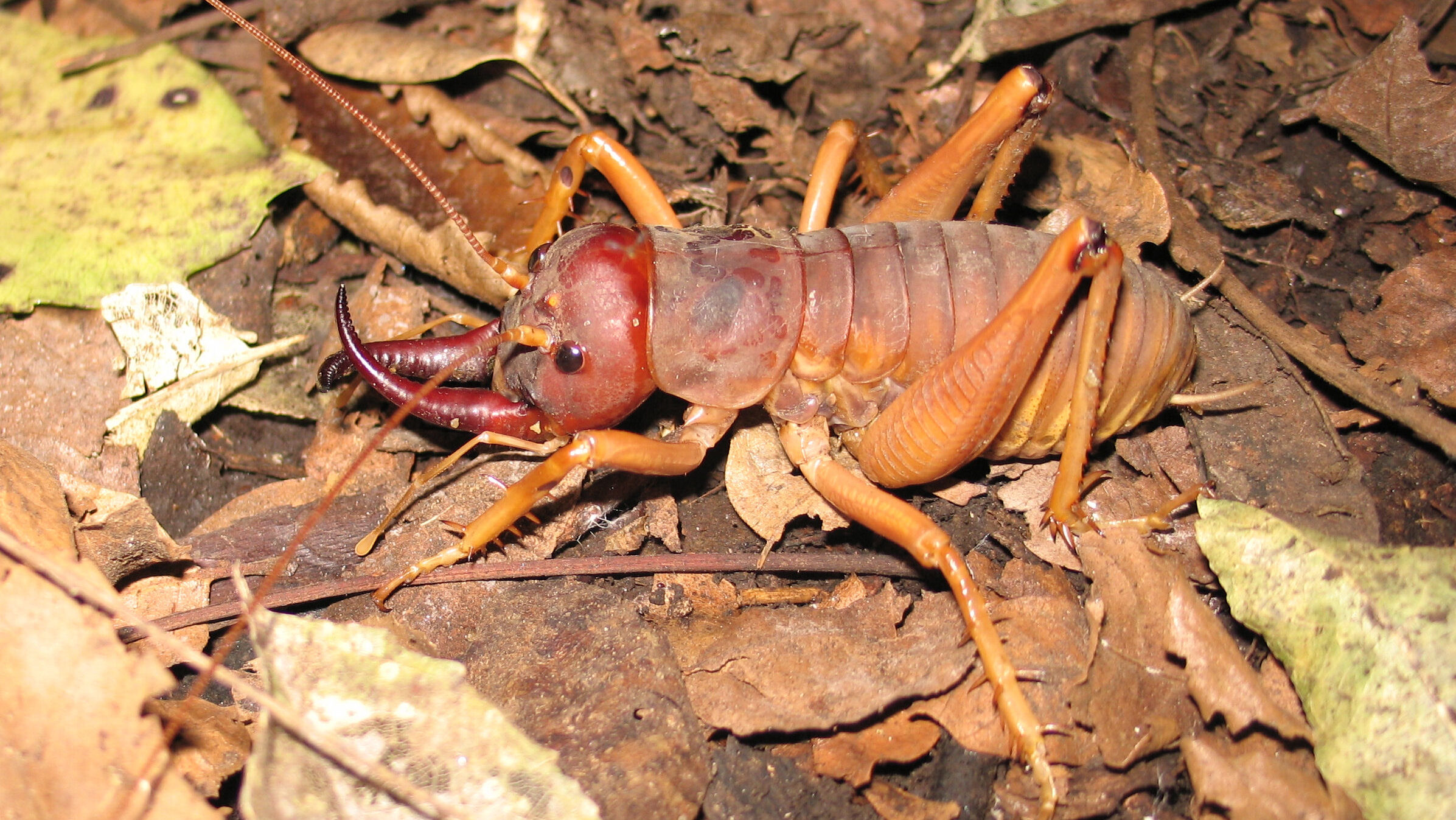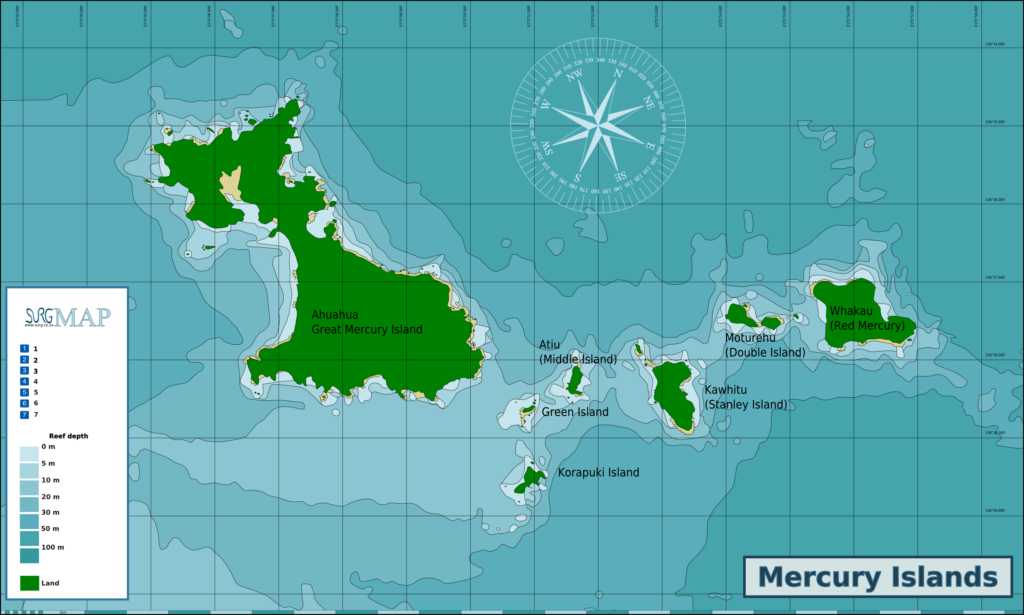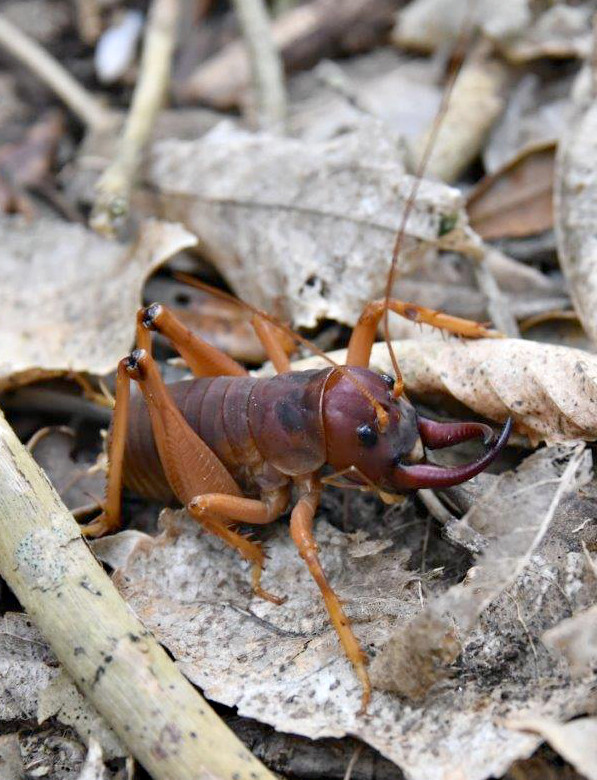The research happened a decade ago now – this paper was published back in 2008 – but how many people have even heard of the large, carnivorous Mercury Island tusked weta (Motuweta isolata), let alone the extraordinary story of its step back from the cliff-face of extinction?

Despite its large size (adult body length 46–73 mm; mass 8.6–34 g), the Mercury Island tusked weta’s secretive nature and rarity kept it hidden from scientific view and it was only discovered in 1970. It is found only in the Mercury Island group and would once have occurred on several of the islands. By the time it was discovered, it was found only on 13 hectare Middle Island, making it very vulnerable to extinction. But it’s rarity also made translocation a risky prospect.

This account, outlining the weta rescue and monitoring of translocated populations was written by Ian Stringer and Rob Chappell from the Department of Conservation and published in the Journal of Insect Conservation. As we learn more about our rarer insect species, and possibly discover new ones, some of the techniques developed and evaluated here are likely to be needed again.
“These experimental transfers were made possible because Winks and Ramsay developed a method for captive-rearing tusked weta. Their work was initiated by the Mercury Islands Tusked Weta Recovery Group which was formed in 1990 by the New Zealand Department of Conservation soon after the vulnerable status of this insect was recognised. The aim was to establish additional populations of this weta on other islands to reduce the chance of accidental extinction.”
The captive breeding programme was necessary as it had already been determined that there were too few weta on Middle Island to effect wild-to-wild transfers.
“Two females and one male weta were collected from Middle Island in 1998 to captive breed insects for the experimental transfers described here. The intention was to make additional transfers of weta captive-bred from a larger number of insects collected from Middle Island if the experimental transfers were successful. However, the three weta collected for captive rearing were amongst the last 9 to be seen on Middle Island following a severe drought in 1993–1994.”
Tusked weta have not been seen on Middle Island since January 2001, although it’s possible some survivors eluded the 11 unsuccessful searches, involving 308 person hours, that were carried out between 2001 and 2007.
“These insects may still be present in very low numbers because they are difficult to find—they can remain in their chambers for many weeks and usually emerge only on moonless nights when it is calm, warm and humid.”

With the success of the breeding programme, offspring of the two females and one male weta were available for translocation, meaning there was still a chance of saving the species. Genetic diversity among the captive-bred weta was, however, likely to be low.
“Half-grown or larger insects from the captive breeding programme were released onto nearby Red Mercury Island and Double Island in 2000 and 2001 to reduce the potential for accidental extinction. Most (108) were released under individual artificial cover objects (ACOs)—clear Perspex discs under plastic plant-pot saucers—and 26 were placed in artificial holes in soil.”
Some released weta appreciated the housing provided and didn’t move far from home.
“Usually approximately 10% were found again under ACOs for up to 18 months including, 7.5 months as adults.”
The weta were monitored after their release – a chance to evaluate several different monitoring methods for this hard-to-find species.
“We planned to maximise the information obtained by attempting to monitor weta after they were released to assess their survival. Reproductive success was also assessed but this took longer because of the 2–3 years generation time.”
Growing weta shed their old exoskeletons – which means some of the monitoring methods that are used for small vertebrates simply don’t work with insects.
“Most weta were released as juveniles that could not be followed individually because any marks or tags on cuticle are lost at moulting. Instead, they were released under artificial cover objects (ACOs) with the expectation that some would remain there and allow us to monitor them. This seemed likely because this weta lives in individual underground chambers and repeatedly returns to them at night after feeding on other invertebrates. ACOs can provide a fast and cost-effective monitoring method that does not harm the animal. They can also increase detection rates for rare and cryptic species whilst incurring minimal habitat damage.”
Other methods were also trialled with varying success.
“Other monitoring methods tested were searching plots and using adult weta equipped with harmonic radar transponders (HR transponders) and micro-transmitters to lead us to other untagged weta they paired with. Lastly, as a precaution in case none of the weta were found again, some were released into a predator-proof cage on Red Mercury Island and followed using all of the monitoring methods. In addition, the behaviour of these caged insects immediately after their release was also investigated using infra-red time lapse video to check if they do return to their burrows.”
As well as monitoring survival of the released weta, researchers were keen to confirm they were successfully breeding.
“Trays of suitable oviposition substrate were provided so we could determine when they started ovipositing. Two eggs were found in an oviposition tray in the cage in April 2001 providing the first indication that weta had started to breed. A first instar tusked weta was then found under an ACO in the cage in April 2002, and this was followed by five large juveniles (instars 8–9) in March 2003, one adult (instar 11) in April 2005 and an adult (instar 10) and juvenile (instar 9) in July 2006.”
Tusked weta have a lifespan of 1.7-3.2 years, meaning weta found after the first few years, were offspring bred in the wild after the translocations.
“All of the released weta would have become adult by April 2001 and then have died naturally within a year so the large juveniles found in March 2003 were their progeny, one to 1.5 years old. Given that their lifespan is usually 1.7–3.2 years or longer when eggs delay hatching for a year, then by 2006 the progeny would have completed at least one and possibly up to three generations on these islands.”

These experimental releases demonstrate that tusked weta can breed and survive on both Double Island and Red Mercury Island.
“Ongoing monitoring is planned to confirm long-term success. Inbreeding depression is likely so supplementation from Middle Island is required but they may be extinct there. Scraping the soil to expose weta in underground galleries was the best monitoring method. Few were found by searching with lights at night, but adults could be located by following other adults equipped with harmonic radar transponders or microtransmitters. One method that did not occur to us was using footprint tracking tunnels. This could clearly work because tusked weta footprints, identifiable by shape and size, were found in one of the tracking tunnels used to warn of rodent incursions on Red Mercury Island in February 2007.”
The researchers identified several key things that contributed to the success of the translocation:
- First, a recovery group was formed which initiated the ecological and behavioural investigations of McIntyre (2001), the research into captive-breeding. It also made the decision to use the first weta produced from the captive-breeding programme in the present experimental transfers.
- Second, the early success in developing a captive rearing method by Winks and Ramsay (1998) was crucial in making the transfers possible.
- And lastly, the release sites were close to Middle Island so similarities in climate and vegetation cover probably contributed to the weta’s survival.
Luck was also involved. The captive-breeding programme was initiated just in time.
“The three weta collected for captive-breeding happened to be amongst the last seen on Middle Island and if this weta is now extinct on Middle Island, then it is indeed fortunate that the transfers did succeed.”
The full account is published in the Journal of Insect Conservation. Only the abstract is freely available to non-subscribers.

